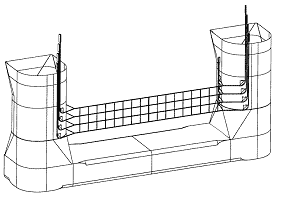Riser Protection Nets and other marine systems
TTI provides technical expertise relating to ropes and chains in marine applications.
As an acknowledged leader in the technology of synthetic fibre ropes, TTI offers independent advice, specification and design services for all types of marine applications.
Riser Protection Nets
Riser Protection Nets (RPN) are sometimes necessary to protect vulnerable risers from impact by an errant supply boat.
Only fibre ropes have the properties that allow RPNs to be successfully engineered, Elastic Modulus being the key property. This allows a net to be designed so that the energy of an impact can be absorbed (through conversion to strain energy) within the strength capability of the ropes.
RPNs have been deployed on eleven major TLP and FPS projects to date of which only the first two of these systems were not designed by TTI.
Riser Protection Nets using Synthetic Ropes Offshore Facility Installed Material Main Span Ropes Hutton TLP (Conoco) 1984 Polyester 200 tonne MBS Snorre TLP (Saga) 1991 Nylon 200 tonne MBS Auger TLP (Shell) 1993 Polyester 360 tonne MBS Heidrun TLP (Conoco) 1995 Polyester 400 tonne MBS Asgard B FPS (Statoil) 2000 Polyester 600 tonne MBS MODEC Prince Mini TLP 2001 HMPE 218 tonne MBS MODEC Marco Polo Mini TLP 2002 HMPE 240 tonne MBS AIOC PDQ Jacket Caspian Sea 2004/10 HM Twaron 425 tonne MBS NADL - Floating Ice Protection Net 2014 Polyester 11.2 tonne MBS Total MOHO Nord TLP 2015 Polyester 37 tonne MBS Ichthys CPF - INPEX 2017 HM Polyester PEN 870 tonne MBS Typical features of a riser protection net:

Main Ropes spanning between the columns are the main components of the net (there may be 3 or more).
Main ropes have a “span” section and two “wing” sections.
Vertical ropes link the main ropes together to prevent a boat slipping between them and to activate some sharing of the work between the main ropes.
Engineering an RPN for optimal performance, durability and cost is a complex but familiar task for TTI. Some of the key design considerations are:
- Net Configuration, Arrangement & Dimensions
- Rope Sizes, Materials & Construction (specs.)
- Design Pretension Level and Tolerances
- Boat Impact Performance (energy & penetration)
- Environmental Loading (ice, marine Growth, waves, current, etc.)
- Strength, Fatigue & Durability Assessments
- Installation and Tensioning Requirements
- Attachment Hardware and Ancillary Structures
A boat impact analysis is done to determine the energy absorbed by the net at progressive stages of penetration by the impact point.The Riser Protection Net will be subjected to wave action which will also need to be considered in the design. A hydrodynamic analysis must therefore be carried out to determine the response of the net to wave loads in the extreme environmental conditions and also to provide data for conducting a fatigue analysis.
Riser Tethers
The usual role of the tethers is in restraining the geometry of the flexible riser system. The most typical riser tether applications are in the restraint of submerged riser arch buoys and in controlling the touch-down geometry of “lazy” flexible riser configurations.
Design considerations focus mainly on the strength and durability of the tethers, with other important aspects being length and length tolerance (including the effect of creep), rope construction, terminations and encapsulation. The full range of design aspects considered by TTI include:
- Configuration, Arrangement & Dimensions
- Rope Sizes, Materials & Construction (specs.)
- Environmental Loading (marine growth, waves, current, VIV etc.)
- Performance in “Near” and “Far” Design Cases
- Rope Strength and Fatigue Assessments
- Wear, Creep and other Durability Issues
- Handling and Installation Requirements
Riser buoy tethers are often engineered using chain, however, polyester rope tethers have been found to be considerably more effective in this application. Advantages in using synthetic fibre ropes over steel wire or chain include:
- Very low weight – so no additional buoyancy is needed to support the tethers.
- Durability – better than steel for resistance to corrosion and fatigue.
- Ease of handling – simpler installation procedures using divers or ROVs.
Some of the more notable riser tether projects using synthetic fibre ropes are:
Synthetic Ropes used in Riser Tether Applications Offshore Facility Installed Material Main Span Ropes AHL - Ivanhoe/Rob-Roy 1989 Polyester 4 x 100 tonne MBS * Shell - Teal & Guillemot 1996 Polyester 4 x 200 tonne MBS * Chevron – Benchamas 1999 Polyester 2 x 112 tonne MBS * Saga – Vigdis 1996 Aramid 1 x 100 tonne MBS Norsk Hydro – Njord 1997 Aramid 28 x 105 tonne MBS BP - Foinaven 1997 Aramid 14 x 53 tonne MBS Statoil – Lufeng 1997 Aramid 8 x 70 tonne MBS Talisman – Buchan 1999 Aramid 2 x 405 tonne MBS * * Tethers used for configurations with buoyant riser arch support(s). Guideline & Practice Development
TTI advises and works with professional bodies, classification societies, regulatory and other organisations developing guideline and recommended practice documents for moorings. Such contributions include:
- OCIMF Single Point Mooring Hawser Guidelines.
- Engineer’s Design Guide for Deepwater Fibre Moorings
- ABS Guidance Notes on the Application of Synthetic Ropes for Offshore Mooring
- API RP2SM Design and analysis of Synthetic Rope Mooring Systems.
- Minerals Management Service
Marine Systems Design

/NQA-ISO-9001-Logo-UKAS.jpg)
/NQA-ISO-45001-Logo-UKAS.jpg)
